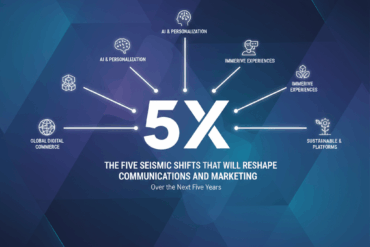By Katie Jewett
Consumers today aren’t just consuming content—they’re scrutinizing it. In an era where personalization is expected and values matter more than ever, brands must go beyond simply being informative or entertaining. To truly connect, content must be relevant, trustworthy and reflective of the brand’s role in society. And that means rethinking not only what the content says but also how it’s created, delivered and perceived.
Staying Relevant In The Content Economy
Below are three essential shifts brands must make to stay relevant in today’s content economy.
1. Think beyond product-centric messaging.
Modern consumers expect more than just promotional messaging—they want brands to stand for something meaningful and worthwhile. In an April 2024 Direct Digital Holdings study, 81% of Gen Z consumers said that diversity and multiculturalism significantly influence the brands they support. This highlights the significance of diversity, equity and inclusion (DEI) in influencing purchasing decisions among this generation. Furthermore, a 2019 study by Sprout Social reveals that “70% of consumers say it’s important for brands to take a stand on public issues.” This reflects a growing expectation for brands to engage actively in societal conversations.
That doesn’t mean abandoning performance-driven content. However, it does mean rebalancing content strategies to include storytelling that reflects the audience’s values. Brands that sustain their commitment to meaningful causes—not just through one-off campaigns but with consistent content across channels—build deeper consumer trust and long-term loyalty.
2. Prioritize privacy in distribution.
Even the most resonant message can fall flat if it’s delivered in a way that feels intrusive. As privacy concerns escalate and third-party cookies are phased out, brands must evolve their approach to targeting and reaching their audiences.
Research conducted by the Harris Poll in 2023 shows that 70% of consumers have taken action to protect their online privacy, such as blocking cookies or using incognito browsers. And a 2022 study from Cisco shows that 37% have abandoned brands due to dissatisfaction with their data practices. In response, brands are exploring new privacy-first targeting methods. One example is “predictive audiences,” which use contextual signals, such as time of day, device type or content engagement behaviour, to identify audiences more likely to interact with branded content, all without relying on personal identifiers.
These strategies strike a balance between relevance and respect, allowing brands to maintain performance while honouring consumer preferences.
3. Use AI thoughtfully in content creation.
Generative AI has unlocked new possibilities for content marketers, including rapid idea generation, tone optimization and real-time iteration, to name a few. But with great power comes new scrutiny. Can consumers tell the difference between human- and AI-generated content? And does it matter?
In a 2023 study, most consumers were unable to reliably distinguish AI-written content from human-created articles. In fact, many found AI content to be more personable and enjoyable, possibly due to its simplicity and accessibility. However, human-written content still ranked higher in terms of educational value and attention retention.
The takeaway? AI can be a powerful co-creator, particularly for content that needs to be concise and digestible. But for messaging that requires depth, education or emotional nuance, human writers still lead. Transparency matters too. Brands must communicate how they’re using AI and ensure outputs are accurate, on-brand and ethical.
Actionable Steps For Marketers
To create brand content that connects, performs and lasts, marketers should align strategy and execution with today’s consumer expectations. Here are some practical ways to start:
• Lead with value-driven storytelling. Ensure your content reflects your brand’s stance on social issues and commitment to DEI—not just in mission statements but across campaigns, social posts and creative execution. Audiences can spot performative messaging, so aim for consistency and authenticity.
• Design for privacy-first performance. Move beyond third-party cookies by exploring contextual and predictive targeting methods. Use signals such as page context, device type and user behaviour to personalize content delivery while respecting privacy boundaries.
• Use AI as a co-creator, not a crutch. Let AI help with brainstorming, outlining or tone refinement, but reserve human input for strategic storytelling and emotional nuance. Be transparent about how AI is used in your content process, especially for brand-owned channels.
• Simplify complex content without losing substance. Whether through AI tools or human editing, clarity matters. Break down technical concepts, structure for skimmability and prioritize accessibility, especially when speaking to a diverse or global audience.
The Future Belongs To Thoughtful Brands
Content has never carried more weight—or more responsibility. As consumers become more discerning, brands must move beyond traditional tactics and embrace a holistic content strategy—one that integrates purpose-driven messaging, prioritizes privacy and uses emerging tools like AI to scale with care.
The brands that succeed will be those that create not just content but connection.
Feature Image Credit: Getty
By Katie Jewett
Katie Jewett is a vice president at UPRAISE Marketing + Public Relations, helping B2B tech visionaries amplify their voices. Read Katie Jewett’s full executive profile here. Find Katie Jewett on LinkedIn. Visit Katie’s website.
Sourced from Forbes


